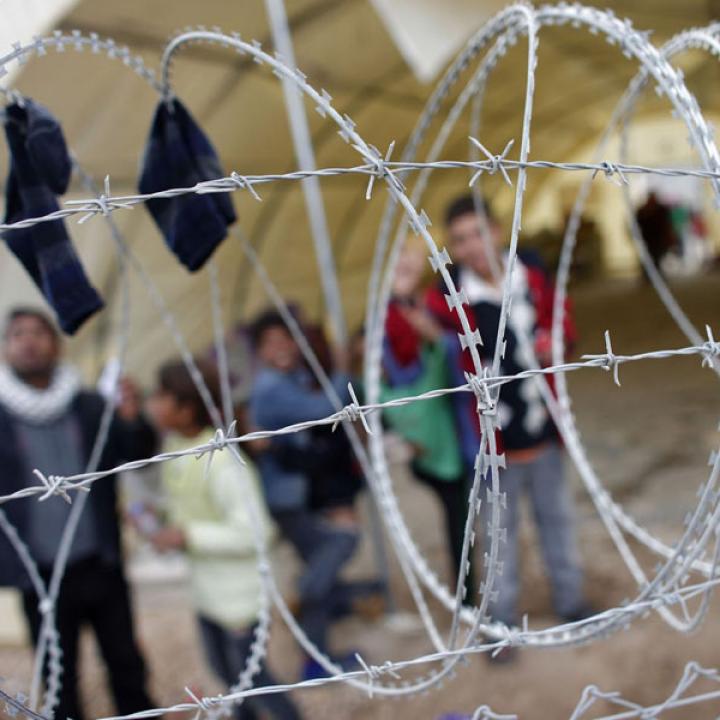
- Policy Analysis
- Fikra Forum
Praxis before Faith in Tackling Radicalism—A Response to Shoresh Khani

Shoresh Khani presents a coherent argument for greater attention to the situation at al-Hawl. Satisfied with the defeat of ISIS, world decision makers seem not much engaged in the residual question of al-Hawl. Some international court involvement is suggested, and de-radicalization efforts are anticipated. If the goal is that ISIS be defeated, many are confident that the mission has been accomplished. The issue, however, is well beyond ISIS.
From Bucca in Iraq, to Bagram in Afghanistan and Sednaya in Syria, the role of detention camps as incubators of radicalism and terrorism has been soberly recognized. The ‘Caliph’ of the ‘Islamic State’ Abu Bakr al-Baghdadi—killed last October in a U.S. raid—was integrated into the web of extreme jihadists in the course of his detention by the United States in Bucca. These experiences helped shape the ‘Caliphate.’ Many of the leaders of Syrian jihadist factions are similarly ‘graduates’ of the Sednaya prison complex, where the regime has reportedly allowed or even fostered the emergence of radical networks towards further exploitation.
It is true that commensurate resources are allocated for these types of facilities to manage and mitigate the dangers, and that deliberate intelligence programs are deployed to gather information and foil terrorist planning. However, the main lesson learned from these experiments in human concentration may be the realization that the benefit of keeping terrorists and potential terrorists off-line is eroded by the risks resulting in the enhancement of their cohesion, militancy, and radicalism.
Compared to Bucca, Bagram, or Sednaya, al-Hawl as a detention facility has more liabilities and fewer assets. The SDF units in charge of securing the camp are less equipped and poorly supplied than those stationed at the aforementioned camps, and have been depleted and demoralized by last year’s perceived abandonment by the U.S. Administration. Their detained population, mostly women and children, is numerous, opaque, and more difficult to control.
More importantly, the camp is located within a region with a considerable affinity for the detainees, and with at best a frustrated hostility towards the SDF. In many ways, al-Hawl does not behave as a detention camp but as an occupied territory, with the detainees often engaging in symbolic (and actual) acts of ‘resistance’—from raising home-made ISIS flags to shouting insults at SDF patrols. An underground economy, bridging outside of the camp has been inevitable to provide lacking supplies, while also engaging in smuggling, human trafficking, and other illicit operations.
The ‘Islamic State’ as a command and control structure has been largely obliterated, and may be in no position to provide aid and support to the camp’s population. Yet inside the camp, the “Women of the Islamic State,” perpetuating harsh religious regimentation, are a testimony to the enduring power of militant jihadism as a portable methodology. In line with the approach adopted and implemented by the ‘Islamic State’ over its years of territorial control, ideology is assumed; it is neither proposed nor debated. Indoctrination is accomplished through praxis—rituals, investment in actions, and routinized complicity. The patterns thus set are self-reinforcing and self-perpetuating. As leadership and institutions, the ‘Islamic State’ is no longer. As methodology, it is alive and well at al-Hawl.
The possibility of defeat—and the potential for resurgence through intransigence—had been anticipated by radical theorists. The resurrection of the ‘Islamist State’ itself is of little importance as long as the totalitarian religious order is communally maintained, burrowed during trying times, and delivered to the next incarnation of an ‘Islamic state.’ In considering the current situation of al-Hawl, it is hard to see what better conditions can be set for such an endeavor. Ending the territorial control of the Caliphate, eliminating the ISIS leadership, and pursuing Islamic State funders and operatives are certainly necessary steps. However, they do not amount to victory against it.
It is a global dereliction of duty, driven by inexcusable short-sightedness and complacency, to abandon the responsibility of managing and interdicting the reemergence of terrorism to the care of the well-meaning but dramatically under-equipped SDF. The al-Hawl camp amounts to a clear and present danger, exposing northeastern Syria to potential unrest certainly but also preparing new human and propaganda tools for the next phase of global terrorist jihad. The immediate cost, political and financial, seems to preclude the most reasonable course of action, that of breaking the camp into components to be assumed by direct stakeholders—including the countries of origin of foreign detainees. Instead, the veneer of global engagement seems limited to yet-to-be-fully-defined role for international courts.
A “re-balancing” of the detention arrangement is imperative. The SDF ought to be provided with more tools, more training, and more funds to manage the task. But the camp need in turn be re-conceived as a detention facility—a temporary transit point while better solutions are identified, not as a territory under a permanent lukewarm occupation.
The catch-22 situation seems to be that “de-radicalizing” ISIS families is perceived as a pre-requisite to their exit from the camp, while their mere presence in the camp is an insurmountable obstacle to said de-radicalization efforts. Counterintuitively, it is important to recognize that the ideological radicalism of the camp population is largely the visible aspect of its behavioral radicalism. Extracting these families from the camp is the first step towards giving them a chance to escape the radical stranglehold. The longer they stay in the camp, the less the possibilities of success at shedding the methodology and ideology of terrorism, and the more potential danger for the whole world.


